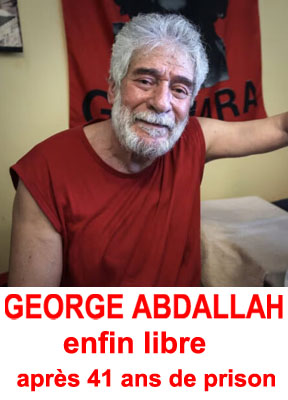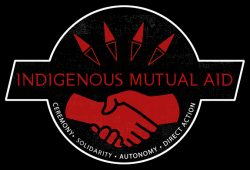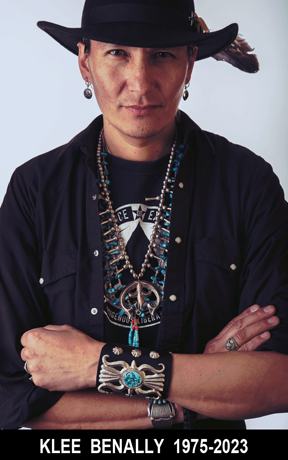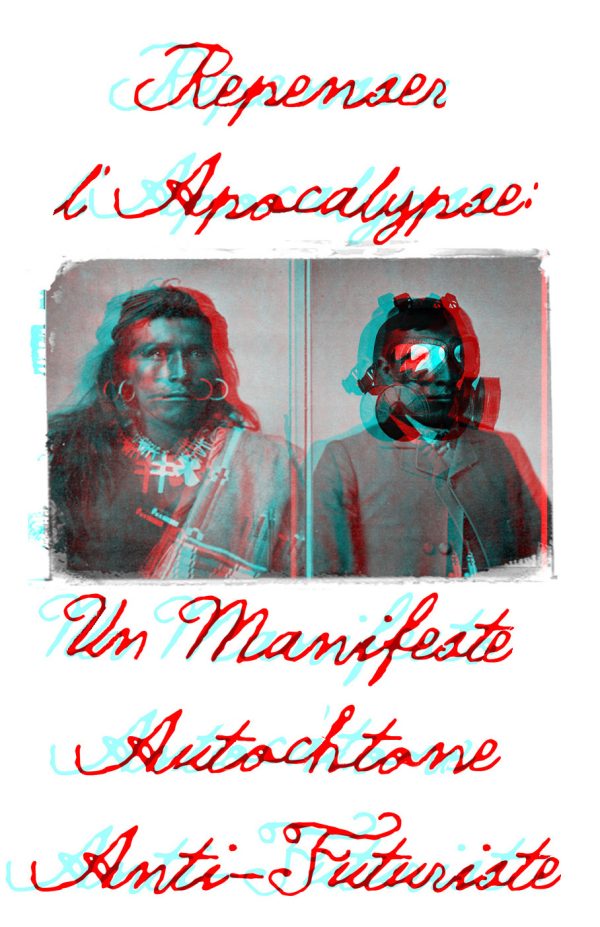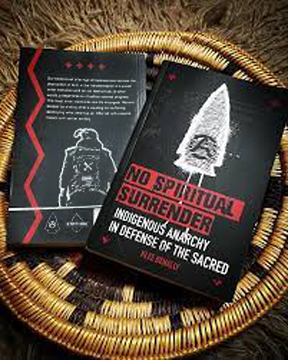Christine Prat, CSIA, français
Octobre 20, 2018
Also published on Censored News
Two Water Protectors, who have been fighting and suffering a lot in Standing Rock, Nataanii Means and Tufawon, are now back to Europe for a “Resilience Tour”. In Paris, they took part in several events, to celebrate AIM’s 50th Anniversary, and CSIA’s 40th Anniversary.
On October 12th, in the afternoon, a gathering took place to honor the AIM and pay a tribute to the leaders who have passed to the Spirit World, and, in the evening, Raye Zaragoza (Akimel O’odham/Xicana), Nataanii Means and Tufawon had a show.
The evening started with beautiful songs by Raye Zaragoza.
Then, Nataanii and Tufawon started with their hip-hop show. Nataanii presented himself and delivered a speech about the AIM leaders who left us, explained how complicated it was without the Elders, and said that their struggle to protect water is still going, now against the pipeline Line 3 of Enbridge.
Nataanii Means presented himself, saying that he came from three different Nations: Oglala Lakota, Omaha and Dineh (Dineh being often known as Navajos).
Then he talked about the AIM:
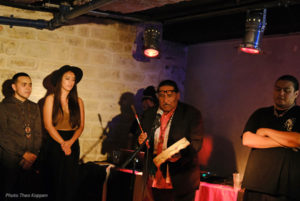 “My father fought for a long time, alongside my auntie and my uncle here, Jimbo and Jean. They all worked together for a long time. Jimbo talked about how our past leaders are past away now, no matter whoever they grouped with. Jean said it too. Everyone they grouped with in the movement, they are gone now.
“My father fought for a long time, alongside my auntie and my uncle here, Jimbo and Jean. They all worked together for a long time. Jimbo talked about how our past leaders are past away now, no matter whoever they grouped with. Jean said it too. Everyone they grouped with in the movement, they are gone now.
I am a product of what they built. One day, I shall be an ancestor to one of my people. So are you. That’s why we have to start thinking collectively as conscious people.
We are fighting another pipeline, in Minnesota. It’s called Line 3, and you can look it up on the Internet, at www.stopline3.org. On Facebook, look up Ginew Collective, g, i, n, e, w. Look that up.
But a few weeks ago, me and Tufawon, we just came from that camp. We’re fighting that billionaire company, and I was sitting there, in a meeting, and I looked around, because a question came up. It was a really hard question, and I expected somebody else to answer it. I expected one of my Elders to be there to answer it. But they were not there, there was nobody there. There was us. And that was a new feeling for me, to be there without these people. But that’s how life is, you understand that.
You know, it’s hard for me and Rafa [Tufawon] to both be here. You know that, leave those guys behind to do a lot of work.
So, the least we can do for them is to ask you to go home and look up stopline3.org and Ginew Collective, and share with your circle, donate and spread the word.”
Then, Nataanii and Tufawon went back to playing music.
Excerpt from the info page of stopline3, there is much more info on this site – among others, several video interviews of Winona La Duke – thus look it up:
The existing Line 3 is an Enbridge pipeline that ships crude oil from Alberta to Superior, Wisconsin. It spans northern Minnesota, crossing the Leech Lake and Fond du Lac reservations and the l855, 1854, and l842 treaty areas. And it is a ticking time bomb. It was built with defective steel in l96l, has had numerous ruptures and spills, and is running at half pressure because of severe corrosion. Instead of cleaning up this liability, Enbridge wants to simply leave it in the ground forever, and cut a brand new energy corridor through our best lakes, wetlands, and wild rice beds, and the heart of Ojibwe treaty territory. They first proposed this new route for the Sandpiper pipeline in 2013, but years of fierce resistance in Minnesota drove them to cancel that project and buy a share of the Dakota Access pipeline instead. At $7.5 billion, the proposed new Line 3 would be the largest project in Enbridge’s history and one of the largest crude oil pipelines in the continent, carrying up to 915,000 barrels per day of one of the dirtiest fuels on earth, tar sands crude. They call it a “replacement” but it is larger, with higher volume, in a new corridor. First Nations, tribal governments, landowners, environmental groups, and communities across the Great Lakes have been fighting for 5 years now to stop this new corridor and #StopLine3. We are here to protect the water and our future generations.
TOURNEE ‘RESILIENCE’ DE DEUX PROTECTEURS DE L’EAU: LA LUTTE CONTRE LES OLEODUCS CONTINUE
Christine Prat, CSIA English
20 octobre 2018
Egalement publié en anglais sur Censored News
Deux Protecteurs de l’Eau, qui ont combattu et beaucoup souffert à Standing Rock, Nataanii Means et Tufawon, sont de retour en Europe pour une tournée intitulée “Résilience”. A Paris, ils ont pris part à diverses manifestations, pour célébrer le 50ème Anniversaire de l’AIM et le 40ème Anniversaire du CSIA-nitassinan.
Le 12 octobre, l’après-midi, il y avait eu une réunion pour commémorer l’AIM et rendre hommage à ses dirigeants maintenant passés dans l’Autre Monde, et le soir, Raye Zaragoza (Akimel O’odham/Xicana), Nataanii Means et Tufawon ont donné un concert.
La soirée a commencé avec les chants mélodieux – et engagés – de Raye Zaragoza.
Puis, Nataanii et Tufawon ont entamé leur concert hip-hop. Nataanii s’est présenté et a parlé des dirigeants de l’AIM qui nous ont quitté, et expliqué que c’était très difficile de continuer sans les Anciens. Il a expliqué aussi que leur lutte pour protéger l’eau continue, actuellement contre l’oléoduc Line 3, de la firme Enbridge.
Nataanii s’est présenté, à la manière traditionnelle. Il dit qu’il était issu de trois Nations différentes: Oglala Lakota, Omaha et Diné (‘Diné’ étant souvent connus sous le nom de ‘Navajos’).
Puis il a parlé de l’AIM:
 “Mon père s’est battu pendant des années, avec à ses côtés ma tante et mon oncle ici présents, Jimbo et Jean. Ils ont travaillé ensemble très longtemps. Jimbo a parlé tout à l’heure de nos dirigeants qui nous ont quitté, à présent, peu importe à quel groupe ils appartenaient. Jean l’a dit aussi. Tous ceux avec qui ils se sont groupés, dans le mouvement, nous ont quitté maintenant.
“Mon père s’est battu pendant des années, avec à ses côtés ma tante et mon oncle ici présents, Jimbo et Jean. Ils ont travaillé ensemble très longtemps. Jimbo a parlé tout à l’heure de nos dirigeants qui nous ont quitté, à présent, peu importe à quel groupe ils appartenaient. Jean l’a dit aussi. Tous ceux avec qui ils se sont groupés, dans le mouvement, nous ont quitté maintenant.
Je suis le produit de ce qu’ils ont construit. Un jour, je serai un ancêtre pour quelqu’un de mon peuple. Vous aussi. C’est pourquoi nous devons nous mettre à réfléchir collectivement, en tant que gens conscients.
Nous combattons un autre oléoduc, dans le Minnesota. Ça s’appelle Ligne 3. Vous pouvez chercher les infos sur l’Internet, sur le site stopline3.org. Sur Facebook, cherchez Ginew Collective, g, i, n, e, w. Allez y voir.
Mais il y a quelques semaines, moi et Tufawon, revenions tout juste de ce camp. Nous combattions cette compagnie qui vaut des milliards, et j’étais là, dans une réunion, et j’ai regardé autour de moi, parce qu’une question avait été posée. C’était une question très difficile, et je m’attendais à ce que quelqu’un d’autre réponde. Je m’attendais à ce que l’un de nos Anciens soit là pour répondre. Mais ils n’étaient pas là, personne n’était là. Seulement nous. Et ce fut un sentiment nouveau pour moi, d’être là sans ces gens. Mais c’est la vie, vous le savez bien.
Vous savez, c’est dur pour moi et Rafa [Tufawon] d’être ici, tous les deux. Vous savez ce que c’est, on laisse les gars derrière pour faire un travail énorme.
Donc, le minimum que nous puissions faire pour eux, c’est de vous demander, en rentrant chez vous, d’aller sur le site stopline3.org et Ginew Collective, et de partager avec votre entourage et vos connaissances, de faire des dons et de transmettre l’info.”
Puis, Nataanii et Tufawon sont retournés à la musique:
Extrait de la page d’information du site stopline3. Il y a beaucoup plus d’informations sur ce site – entre autres des vidéos d’interviews de Winona La Duke – donc allez y voir:
La Ligne 3 existante est un oléoduc de la firme Enbridge qui transporte du brut d’Alberta jusqu’au lac Superior, dans le Wisconsin. Il part du nord du Minnesota, et traverse le Lac Leech et les Réserves de Fond du Lac et les régions des traités de 1855, 1854 et 1842. C’est une bombe à retardement. Il a été construit en 1961 avec de l’acier défectueux, il y a eu de nombreuses fissures et marées noires, et il ne fonctionne qu’à la moitié de la pression, à cause de l’extrême corrosion. Au lieu de nettoyer cet oléoduc qui pose tant de problèmes et d’incertitudes, Enbridge veut tout simplement le laisser dans le sol pour toujours, et ouvrir un nouveau corridor à travers nos plus beaux lacs, zones humides et champs de riz sauvage, et à travers le cœur du territoire Ojibwe selon les traités. Ils ont d’abord proposé ce nouveau tracé pour l’oléoduc Sandpiper en 2013, mais des années de résistance féroce dans le Minnesota, les a forcés à renoncer au projet et à acheter des parts du Dakota Access Pipeline à la place. Au prix de 7,5 milliards de dollars, le nouveau projet de Ligne 3 serait le plus grand de l’histoire d’Enbridge, et l’un des plus grands oléoducs pour le brut du continent, transportant jusqu’à 915 000 barils par jour du carburant le plus sale sur terre: le brut de sables bitumineux. Ils intitulent cela un “remplacement”, mais c’est plus grand, avec un plus grand volume, dans un nouveau corridor. Les Premières Nations, les gouvernements tribaux, les propriétaires terriens, les groupes écologistes et les communautés dans la région des Grands Lacs, combattent depuis 5 ans pour bloquer ce nouveau corridor et la Ligne 3, #StopLine3. Nous sommes là pour protéger l’eau et les générations futures.



